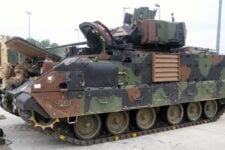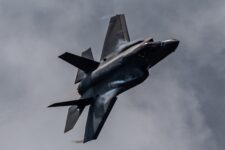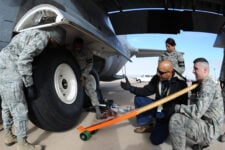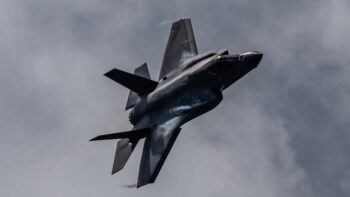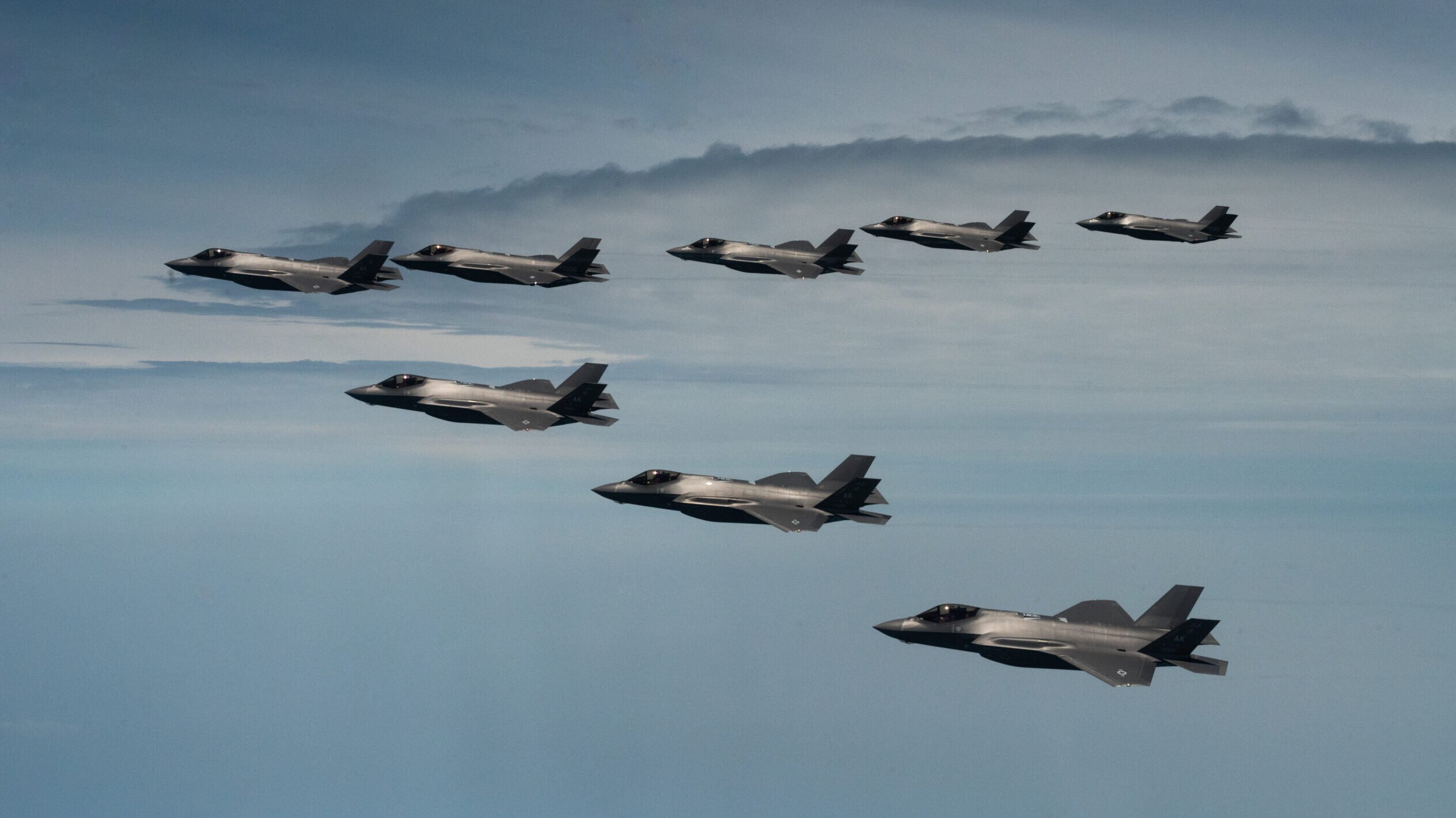
U.S. Air Force F-35 Lightning IIs from the 356th Fighter Squadron at Eielson Air Force Base fly side by side with Republic of Korea Air Force F-35s from the 151st and 152nd Combat Flight Squadrons as part of a bilateral exercise over the Yellow Sea, Republic of Korea, July 12, 2022. (U.S. Air Force photo by Senior Airman Trevor Gordnier)
WASHINGTON — For the many weapon systems in the portfolio of Christopher Lowman, few underscore the challenges of platform sustainment like the F-35 Joint Strike Fighter, a program with numerous foreign partners and an intricate global supply chain expected to support a planned fleet of thousands of jets.
Lowman, the assistant secretary of defense for sustainment, has taken a leading role in the Pentagon to boost the Lockheed Martin-made stealth fighter’s disappointing mission capable rate of just 55 percent as of March 2023, as well as ensure the global fleet can stand up to the pressures of peer conflict.
Following a Government Accountability Office report that illuminated numerous challenges with sustaining the F-35, as well as a tabletop exercise run by the Pentagon that examined how the fighter would perform in a contested environment, Breaking Defense sat down with Lowman in his Pentagon office to discuss current challenges with the fleet, lessons learned from the program for future acquisitions and why the government and Lockheed disagree on how much sustainment data the Pentagon really needs.
This transcript has been edited for length and clarity.
BREAKING DEFENSE: A lot of themes came out from a large GAO report recently on F-35 sustainment, and I wanted to start with a case where I think it’s fair to say that in the past, DoD has dropped the ball. A particular example I’m thinking about is the lack of depot capacity for the fleet, where the GAO report kind of points at an attitude of prioritizing procurement over sustainment. How are you thinking about the lack of depot capacity?
CHRISTOPHER LOWMAN: There are a couple of key determinants for future sustainability of a complex weapon system. It’s not F-35 unique, and that is investment in initial spares to kind of seed the pipeline with the parts you need as you increase the density of that capability within the fielded force structure. And the second one is investment in depot maintenance capability.
In the case of the F-35, trades were made early on that affected the density of initial spares and that affected the pace at which we could stand up organic depot maintenance capability. So last year, we met a number of different times with the JPO [F-35 Joint Program Office] and the F-35 community writ large, articulated that case, and the department made a decision to take the quantity of aircraft in the 15 to 17 production lot contract, decrease the quantity by a small amount and take those dollars and increase the investment level in organic depot standups.
It takes a period of time to get the capability, get the workforce, prove out the maintenance effectiveness, and then go full operational capability. So we’ll start to see those hit and become operationally capable in ‘24 and out.
The F-35 suffers from certain key degraders [specific subsystems that are leading reasons for lower readiness rates]. What do you think is the right strategy for fixing them in the sense that, does there need to be more pressure on the contractors and the subs to deliver? Is there something that the government needs to be doing differently?
I think it’s a different story for every one of those principal degraders. In some cases, they’re failing faster than the engineering estimates said they’d fail. So they have a lower reliability rating in practice and in service than what the engineers had projected. The solution is to either increase the capacity on repairing to overcome that reliability, to do a material change to fix the reliability problem. Or increase capacity to produce more of whatever is failing, if it’s not a repairable component. So it’s really a combination.
In the case of [F-35 Program Executive Officer Lt. Gen. Mike Schmidt’s] initiative to increase the readiness rates of the F-35 fleet by 10 percent by April of ‘24, he’s got a particular focus on a number of these degraders. He’s spending a lot of time, him and his staff, meeting with sub-tier suppliers who manufacture these parts to address these issues.
Of course, Lockheed’s right there in lockstep with him. The government’s responsible to sustain the readiness of our key warfighting platforms. That’s our mandate. And it’s done through a variety of different concepts. In the F-35’s case it happens to be heavily reliant on contractor logistics support.
On the push for more F-35 sustainment data by the DoD, I asked [Lockheed aeronautics chief] Greg Ulmer about this a few months ago, and he said that the government has all the sustainment data it needs to sustain the fleet, and now it wants beyond that. How would you respond to that, the idea that the government has all the sustainment data it needs to be able to support the fleet?
I think from Mr. Ulmer’s perspective, it is all about where you sit. So the F-35 is sustained predominantly through contractor logistic support. When you rely on that kind of strategy, the government doesn’t need as much data as we would need if the government was responsible to sustain the F-35 organically.
But when you look at the sustainment strategy for F-35 through the lens of a contested logistics environment, and the new national security environment, and the results of the tabletop exercise — which indicated some changes in terms of our visibility of information, flexibility to make changes in response to operational need, the survivability of the strategy — there’s going to be some increased requirements for technical data to include provisioning data and to include the data necessary to catalog parts so they can be assigned national stack numbers, and managed within the service supply chains.
So I think Greg was probably — from that particular point in time, knowing what we had procured and was delivered under the contract, was not a bad answer. But it certainly didn’t accommodate current conversations and future discussions… on the future changes that have to occur.
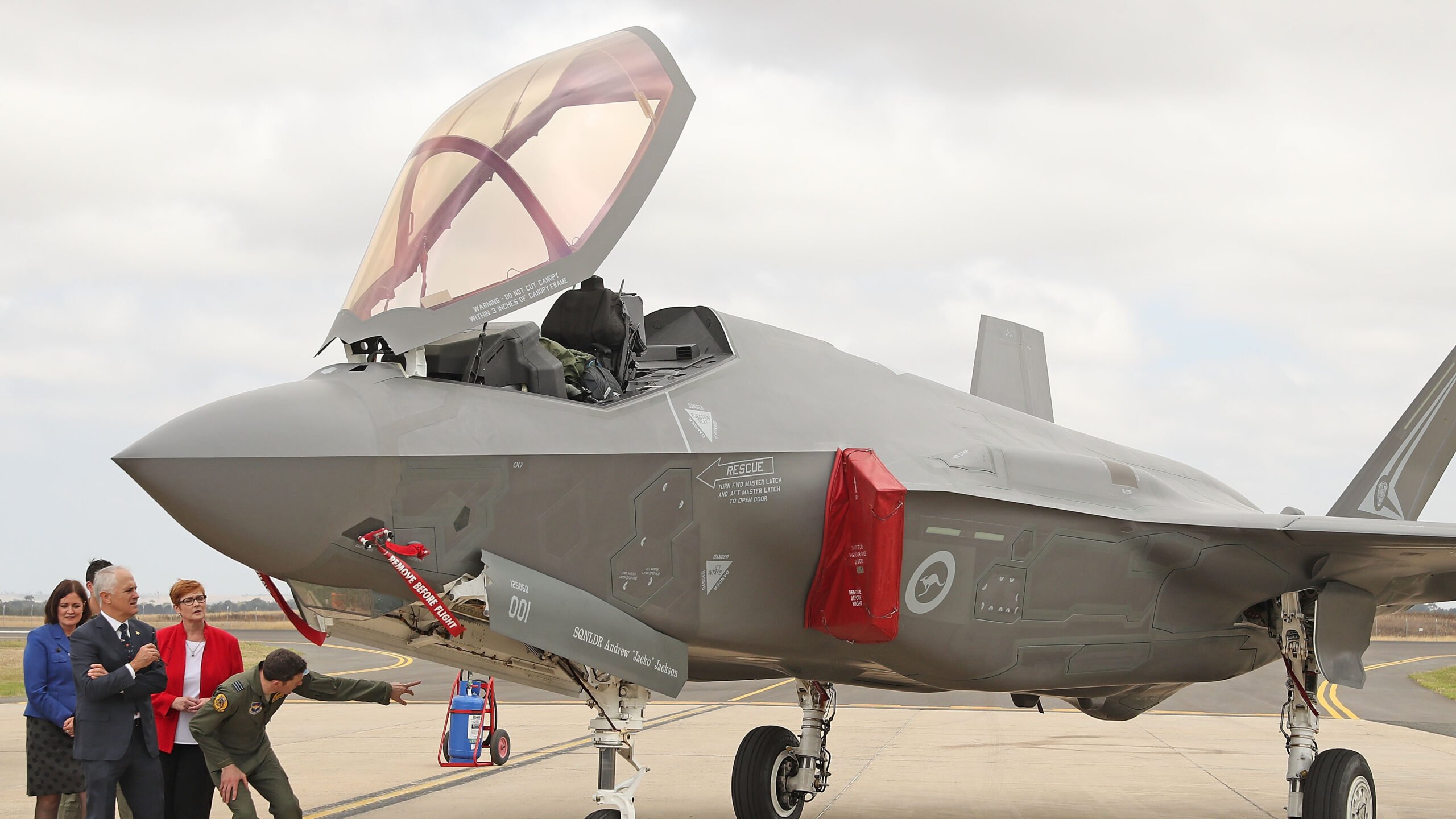
Prime Minister of Australia Malcolm Turnbull, Minister for Defence, Sen. Marise Payne and Minister for Defence Industry Christopher Pyne inspect a Joint Strike Fighter (JSF) F-35 as they attend the Avalon Airshow on March 3, 2017 in Avalon, Australia. (Photo by Scott Barbour/Getty Images)
A GAO audit earlier this year found that over $85 million worth of parts can’t be located. Ulmer’s response to that was Lockheed is compliant with requirements about tracking those parts. What’s the difference between the requirements that exist today and ones you’re thinking about writing for the future to get after this problem and be able to have more granularity in the system?
The F-35 is a little bit unique in the sense that the spares that are in the global spares pool, are government-owned but managed by Lockheed.
[We] have been spending an enormous amount of effort to get Lockheed to a place where they can begin to manage this and have the spares reportable within the GFP [government furnished property] module. So we’ve laid down a requirement to get an initial trial balance of the global spares pool by December of ‘25. There’s a lot of work to get to that initial trial balance, but that really gives us then the basis to … [get] good visibility of all the spares in the global spares pool and then creating the IT connectivity.
It’s just a mismatch between our requirements to have visibility within an auditable government property accountability system, and how F-35 is managed, which is outside of the government property accountability system.
On the access to the program’s data, I think this is maybe also an example of where the government dropped the ball. The government kind of tied its hands from getting access to that data, and now it’s working to catch up on what it should have gotten from the outset. So how do you think of that problem, and how is that informing future weapons procurement decisions?
I wouldn’t characterize it as dropping the ball, because what you have to recognize is that when the F-35 was conceived, when the sustainment strategy was designed, and when the enterprise was going through the acquisition process for F-35, the national security environment was much different than it is today.
So we’re working through this, I call it a campaign of learning. So I happened to start with F-35. We did two [table top exercises] in ‘23, we learned a lot. We’ll do a surface fleet asset in ‘24. Then we’ll follow that on with a series of capabilities that span from cargo aircraft, to subsurface sustainment, to ground force sustainment to understand, how are the designed and contracted sustainment strategies — how do they stand up to the stress of a contested logistics environment in peer competition in the Pacific?
What we found is that systems that are heavily reliant on contractor support, that have a minimum of government-owned intellectual property or access to the intellectual property, that the flexibility to make changes in accordance with a new national security environment is limited.
So we’re pressing this joint concept for contest logistics back into the Defense Acquisition University to begin teaching the PSM [product support managers] workforce through the courses that they have to take to become certified to begin teaching them what they should be looking at as they’re designing weapons systems sustainment strategies that we haven’t traditionally looked at because we were in COIN [counterinsurgency] operations for the last 25 years. Now we’re transitioning back into peer competition where contested logistics makes a difference.
Are you confident that the F-35 enterprise right now could meet the challenge of conflict with a peer competitor and handle the stresses of a contested logistics environment?
Yes.
Army leader dismisses House proposal for drone branch creation
“Operating and defending against the drone threat is something that will be experienced by, you know, all formations at multiple echelons,” said Army Undersecretary Gabe Camarillo.


